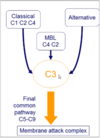Immunology Flashcards
(395 cards)
What are the constitutive barriers to infection?
- Skin
- Mucosal surfaces
- Commensal bacteria
How does the skin act as a constitutive barriers to infection?
- Consists of tightly packed keratinised cells - physically limits colonisation by microorganisms
- Physiological factors - low pH and low oxygen tension
- Sebaceous glands - produce hydrophobic oils, lysozymes and ammonia
How does the mucosal surfaces act as a constitutive barriers to infection?
- Mucus = physical/trapping barrier - contains secretory IgA, lysozymes, antimicrobial peptides and lactoferrin
- Cilia directly trap pathogens - assisted by physical manoeuvres (sneezing/coughing)
How does the commensal bacteria act as a constitutive barriers to infection?
- 100 trillion bacteria normally reside at the surfaces
- Compete with pathogenic bacteria for scarce resources
- Produce fatty acids and bactericidins - inhibit the growth of many pathogens
What are the cells of the innate immune system?
Polymorphonuclear cells
- Neutrophils
- Eosinophils
- Basophils
- Monocytes and macrophages
- NK cells
- Dendritic cells
What are the soluble components of the innate immune system?
- Complement
- Acute phase proteins
- Cytokines and chemokines
What are the key features of the innate immune response?
Identical responses in all individuals Cells express receptors that allow them to detect and home to sites of infection Cells express genetically encoded receptors (PRRs) Phagocytic capacity to engulf pathogens Cells secrete cytokines and chemokines that regulate the immune response
Describe the role of neutrophils.
- Acute inflammation/Migrate rapidly to injury site
- Express receptors for cytokines and chemokines to detect inflammation
- Express Pattern Recognition Receptors to detect pathogens
- Express Fc receptors for immunoglobulin to detect immune complexes
- Perform phagocytosis and oxidative and non-oxidative killing
- Release enzymes, histamine, lipid mediators of inflammation from granules
- Secrete cytokines and chemokines to regulate inflammation
Describe the role of macrophages.
Present within tissue - Express receptors for cytokines and chemokines, express Fc receptors for immune complexes, express PRR - Perform phagocytosis and oxidative and non-oxidative killing - Secrete chemokines and cytokines to regulate inflammation - CAN process and present antigen to T cells
Describe phagocyte recruitment.
- Cellular damage and bacterial products trigger local production of inflammatory mediators (cytokines and chemokines)
- Cytokines activate vascular endothelium increasing permeability
- Chemokines attract phagocytes
How does the innate immune system recognise microorganisms?
Pattern recognition receptors (PRRs) - Toll-like receptors and mannose receptors recognise generic motifs known as pathogen-associated molecular patterns (PAMPs) e.g. bacterial sugars, DNA and RNA Fc receptors on innate immune cells allows them to bind to Fc portion of immunoglobulins to allow phagocytes to recognise immune complexes
Describe endocytosis.
- Opsonins act as a bridge between the pathogen and the phagocyte receptors
- Antibodies bind to Fc receptors on phagocytes
- Complement components can bind to complement receptors (e.g. CR1)
- Acute phase proteins (e.g. CRP) will also promote phagocytosis
What is a phagolysosome?
Phagolysosome = a phagosome fused with a lysosome
- forms a protected compartment in which killing of the organism occurs
Describe oxidative killing.
- NADPH oxidase converts oxygen into reactive oxygen species - superoxide and hydrogen peroxide
- Myeloperoxidase catalyses the production of hydrochlorous acid from hydrogen peroxide and chloride
- Hydrochlorous acid is a highly effective oxidant and anti-microbial
Describe non-oxidative killing.
Killing by release of bactericidal enzymes e.g. lactoferrin and lysozyme into the phagolysosome - The range of enzymes results in a broad range of cover against bacteria and fungi


Describe the role of natural killer cells.
Speacialised lymphocytes that are in the blood and may migrate to inflamed tissue
Express inhibitory receptors for self HLA class 1 which prevents inappropriate activation by normal self-cells
Express range of activatory receptors including natural cytotoxicity receptors that recognise heparan sulphate proteoglycans
Integrate signals from inhibitory and activatory receptors (usually inhibitory signals dominate)
Cytotoxic - kill ‘altered self’ cells (i.e. malignancy or virus-infected cells)
Secrete cytokines to regulate inflammation and promote dendritic cell function
Where are dendritic cells found?
Peripheral tissue
Describe the role of immature dendritic cells.
Detect inflammation - express receptors for cytokines and chemokines
Detect pathogens - express pathogen recognition receptors
Detect immune complexes - express Fc receptors for immunoglobulin
Capable of phagocytosis
What triggers dendritic cells to mature?
They do so following phagocytosis
Describe the role of mature dendritic cells.
Upregulate expression of HLA molecules
Express co-stimulatory molecules
Migrate via lymphatics to lymph nodes
Present processed antigen to T cells in lymph nodes to prime the adaptive immune system
Express cytokines to regulate the immune response


What are the components of the adaptive immune system?
Humoral Immunity - B lymphocytes and antibody
Cellular Immunity - T lymphocytes (CD4+ and CD8+)
Soluble Components - cytokines and chemokines
What are the 4 key features of the adaptive immune system?
- Wide repertoire of antigen receptors - VDJ recombination with mechanisms to delete or tolerate these cells
- Exquisite specificity
- Clonal expansion - cells with appropriate specificity will proliferate during infection
- Immunological memory










































